Walmart is set to open five new automated distribution centers to enhance efficiency and bolster its online grocery business. These state-of-the-art facilities, each spanning 65,000 square meters, will feature advanced refrigerated areas designed to store perishable goods. The investment in these new centers will account for approximately 3.5% of the company’s annual sales.
Walmart recently announced the launch of five automated distribution centers across various locations in the United States. These centers aim to streamline the logistics of fresh products, significantly improving efficiency and strengthening Walmart’s position in the online grocery market.
Walmart’s cutting-edge technology
Each of these new facilities will cover an impressive 65,000 square meters, equipped with cutting-edge refrigeration technology. This technology is crucial for storing perishable products, such as frozen chicken nuggets, ensuring they remain fresh and high-quality for consumers.
Key highlights of Walmart’s new distribution centers:
- Automated Systems: Utilizing the latest automation technology to optimize logistics and reduce manual labor.
- Refrigerated Areas: Advanced refrigeration systems to maintain the freshness of perishable goods.
- Strategic Locations: Positioned across the U.S. to ensure efficient distribution and quick delivery times.
- Significant Investment: Representing about 3.5% of Walmart’s annual sales, showcasing the company’s commitment to innovation and customer satisfaction.
With these new automated distribution centers, Walmart is not only focusing on improving operational efficiency but also aiming to provide a superior shopping experience for its online grocery customers.
By investing in advanced technology and infrastructure, Walmart is set to deliver fresher products, faster deliveries, and an overall enhanced customer experience. Stay tuned as Walmart continues to lead the way in revolutionizing the online grocery industry with these groundbreaking advancements.
Walmart is making significant strides to enhance both its physical stores and online order capabilities, according to the company.
Walmart’s Modernization Efforts
As the largest grocery retailer in the United States, Walmart is actively modernizing its logistics chain. This initiative is in response to the growing demand for delivery services and in-store shopping experiences.
These purchasing trends have significantly contributed to a 22% increase in the company’s e-commerce sales during the last quarter, based on official data.
Automation at Walmart
Walmart has been incorporating automation within its distribution centers for quite some time. This includes facilities that handle non-perishable items and logistics centers designed to streamline the packaging and shipping of online orders.
Automation, along with high-margin businesses like advertising, is a key reason why CEO Doug McMillon announced in April of last year that the company expects to increase its profits faster than its sales over the next five years.
According to the company, automated facilities will enable a more precise understanding of inventory, leading to quicker restocking of products in stores.
Real-Time Inventory Management
“We will know exactly what we have, in what quantity, and where it is, almost in real-time,” Walmart stated to CNBC.
Significant Investment in Automation
The firm noted that the expenditure on these new facilities will represent between 3% and 3.5% of annual net sales, which amounts to approximately $22 billion.
This total investment includes both the expansion of automation and hundreds of store remodels.
The Rise of Robots in Distribution Centers
The use of robots in distribution centers is becoming increasingly common in the retail industry.
For instance, Amazon utilizes robots to enhance efficiency and lower operational costs.
In the evolving world of logistics and retail, automation is making significant strides. Companies are increasingly turning to advanced robotic systems to streamline their operations and improve efficiency. Let’s delve into some remarkable examples of this technological revolution.
The Power of Kiva Robots
One notable example is the use of Kiva robots. These robots have the ability to move entire shelves of products directly to the workers, significantly speeding up the selection and packaging process. This innovative approach not only enhances productivity but also reduces the time and effort required by human workers.
Ocado’s High-Tech Solution
Another impressive instance is Ocado, a British online supermarket, which has developed a highly automated robotic system for its warehouses. These robots navigate through a grid, swiftly picking up products and delivering them to packaging stations with remarkable speed and precision. This system exemplifies the future of warehouse automation.
Kroger’s Adoption of Automation
In the United States, Kroger, one of the largest supermarket chains, has also embraced automation. They have implemented automated centers by leveraging technology from the British company Ocado. This partnership has allowed Kroger to optimize their operations and better serve their customers.
